
The cicadas are a superfamily, the Cicadoidea, of insects in the order Hemiptera. They are in the suborder Auchenorrhyncha, along with smaller jumping bugs such as leafhoppers and froghoppers. The superfamily is divided into two families, the Tettigarctidae, with two species in Australia, and the Cicadidae, with more than 3,000 species described from around the world; many species remain undescribed. Nearly all of cicada species are annual cicadas with the exception of the few North American periodical cicada species, genus Magicicada, which in a given region emerge en masse every 13 or 17 years.

The term periodical cicada is commonly used to refer to any of the seven species of the genus Magicicada of eastern North America, the 13- and 17-year cicadas. They are called periodical because nearly all individuals in a local population are developmentally synchronized and emerge in the same year. Although they are sometimes called "locusts", this is a misnomer, as cicadas belong to the taxonomic order Hemiptera, suborder Auchenorrhyncha, while locusts are grasshoppers belonging to the order Orthoptera. Magicicada belongs to the cicada tribe Lamotialnini, a group of genera with representatives in Australia, Africa, and Asia, as well as the Americas.
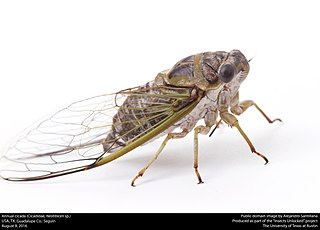
Cicadidae, the true cicadas, is one of two families of cicadas, containing almost all living cicada species with more than 3,200 species worldwide.

The Auchenorrhyncha suborder of the Hemiptera contains most of the familiar members of what was called the "Homoptera" – groups such as cicadas, leafhoppers, treehoppers, planthoppers, and spittlebugs. The aphids and scale insects are the other well-known "Homoptera", and they are in the suborder Sternorrhyncha.

Honeydew is a sugar-rich sticky liquid, secreted by aphids, some scale insects, and many other true bugs and some other insects as they feed on plant sap. When their mouthpart penetrates the phloem, the sugary, high-pressure liquid is forced out of the anus of the insects, allowing them to rapidly process the large volume of sap required to extract essential nutrients present at low concentrations. Honeydew is particularly common as a secretion in hemipteran insects and is often the basis for trophobiosis. Some caterpillars of Lycaenidae butterflies and some moths also produce honeydew. In addition to various sugars, honeydew contains small amounts of amino acids, other organic compounds, and inorganic salts with its precise makeup affected by factors such as insect species, host plant species, and whether a symbiotic organism is present.

The Tettigarctidae, known as the hairy cicadas, are a small relict family of primitive cicadas. Along with more than 20 extinct genera, Tettigarctidae contains a single extant genus, Tettigarcta, with two extant species, one from southern Australia and one from the island of Tasmania. Numerous fossil species have been described from the Late Triassic onwards. Tettigarcta are the closest living relatives of the true cicadas.

Cicada is a supervillain appearing in American comic books published by DC Comics.
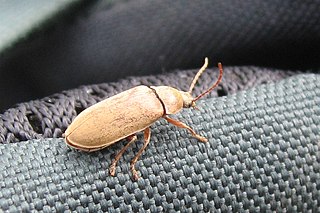
Dascilloidea is a superfamily of polyphagan beetles, comprising two families: Dascillidae and Rhipiceridae.
Cicada lore and mythology is rich and varied as there are about 2500 species of cicada throughout the world, many of which are undescribed and remain a mystery to science. Cicadas have been prized as a delicacy, and are famed throughout the world for their song.

The Cicadinae are a subfamily of cicadas, containing the translucent cicadas. They are robust cicadas and many have gaudy colors, but they generally lack the butterfly-like opaque wing markings found in many species of the related Tibiceninae.
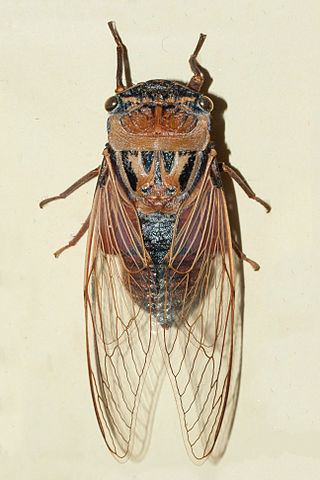
Thopha saccata, the double drummer, is the largest Australian species of cicada and reputedly the loudest insect in the world. Documented by the Danish zoologist Johan Christian Fabricius in 1803, it was the first described and named cicada native to Australia. Its common name comes from the large dark red-brown sac-like pockets that the adult male has on each side of its abdomen—the "double drums"—that are used to amplify the sound it produces.
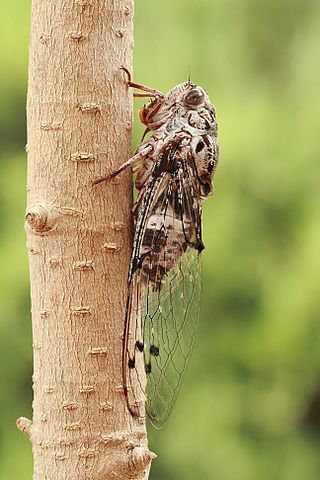
Aleeta is a genus of cicadas with the only species Aleeta curvicosta, one of Australia's most familiar insects. Native to the continent's eastern coastline, it was described in 1834 by Ernst Friedrich Germar.

Sataspes is a genus of moths in the family Sphingidae erected by Frederic Moore in 1858. They are mimics of carpenter bees.
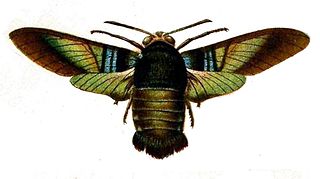
Sataspes tagalica, the brilliant carpenter-bee hawkmoth, is a species of moth of the family Sphingidae first described by Jean Baptiste Boisduval in 1875.

Cicada 3301 is the name given to three sets of puzzles posted under the name "3301" online between 2012 and 2014. The first puzzle started on January 4, 2012, on 4chan and ran for nearly a month. A second round of puzzles began one year later on January 4, 2013, and then a third round following the confirmation of a fresh clue posted on X on January 4, 2014. The third puzzle remains unsolved. The stated intent was to recruit "intelligent individuals" by presenting a series of puzzles to be solved; no new puzzles were published on January 4, 2015. A new clue was posted on X on January 5, 2016. Cicada 3301 posted their last verified OpenPGP-signed message in April 2017, denying the validity of any unsigned puzzle.
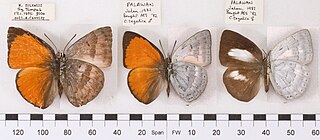
Curetis tagalica, the southern sunbeam, is a species of butterfly belonging to the lycaenid family. It is found in Southeast Asia.

Rhipiceridae is a family of beetles found worldwide. The larva of rhipicerids are parasitoids of cicada nymphs. Rhipiceridae and Dascillidae form the super family Dascilloidea, within the Elateriformia.

Cicadettinae is a subfamily of cicadas in the family Cicadidae. About 230 genera and 1,200 described species are placed in the Cicadettinae.

Chremistica ochracea is a species of cicada in the suborder Auchenorrhyncha, which includes cicadas, leafhoppers, planthoppers, treehoppers, froghoppers and spittlebugs. They are usually referred to as 'thin winged cicada' in Taiwan and 'peaceful cicada' in China due to their abundance in these areas. They can be identified by their green appearance with thin, greenish, transparent wings and are heavily distributed in China, Taiwan, Japan, India and Malaya. However, there are limited number of scientific papers that describe the characteristics and behaviour of this species in detail.

Straight Outta Nowhere: Scooby-Doo! Meets Courage the Cowardly Dog is a 2021 American animated mystery film produced by Warner Bros. Animation, and is the 36th entry in the direct-to-video series of Scooby-Doo films. The film also serves as a crossover between Scooby-Doo and the Cartoon Network show Courage the Cowardly Dog. The film was released on DVD and Digital on September 14, 2021.



















